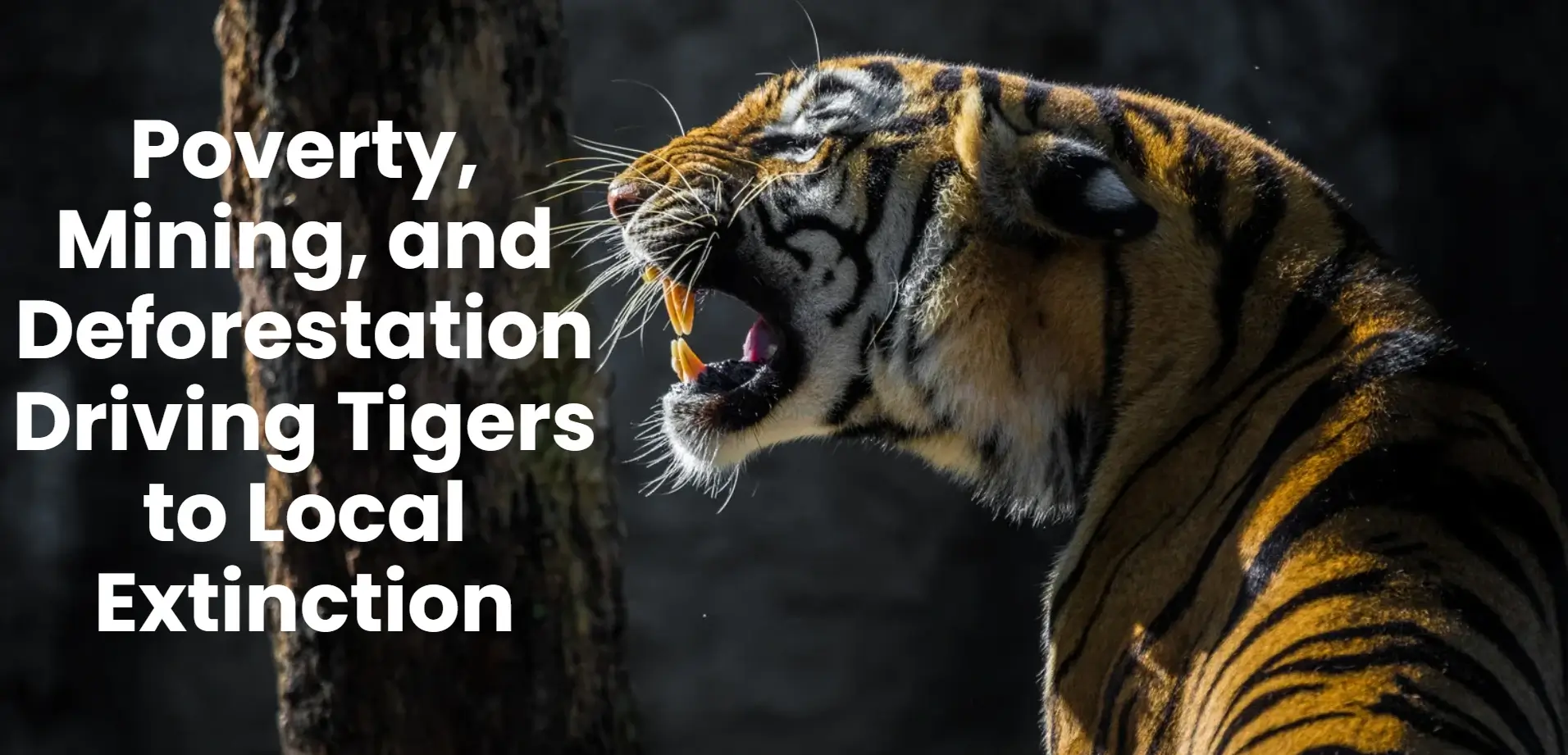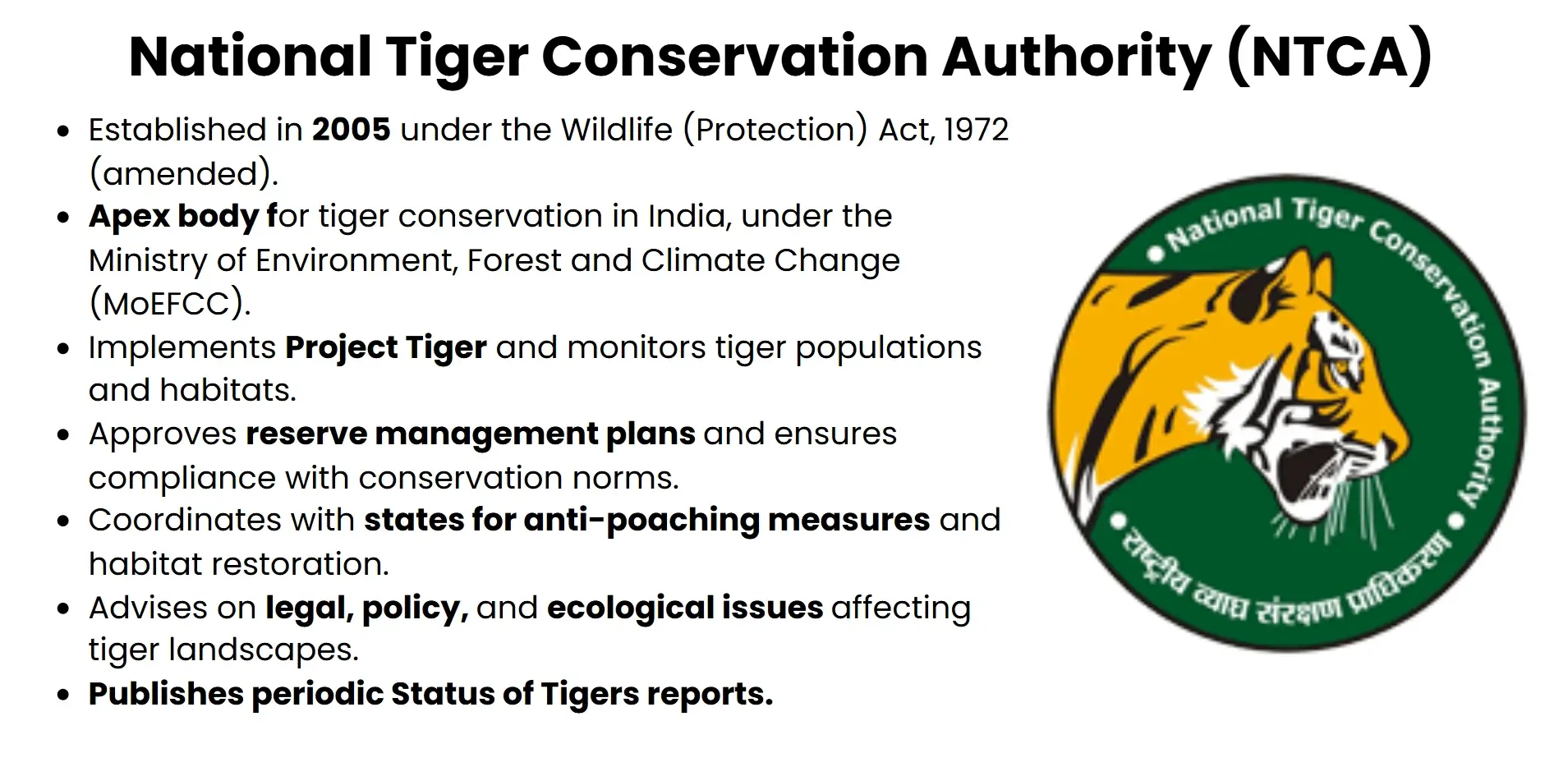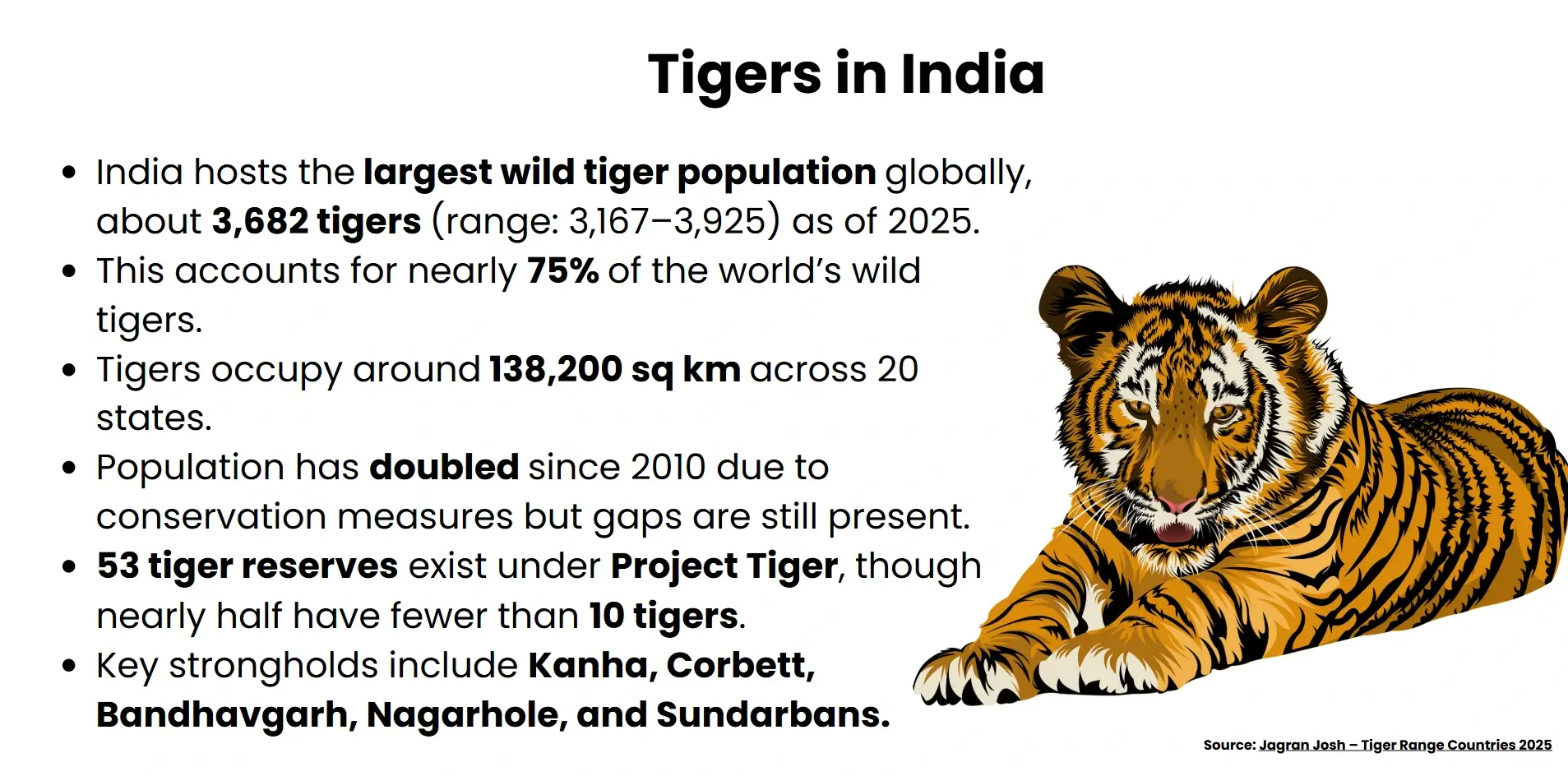In about 18,000 square kilometers of habitat in India, tigers have become locally gone between 2006 and 2018. In regions with low population density but high poverty, snares, bushmeat hunting, and poverty are the main causes of decrease.Rampant poverty, mining and deforestation are ravaging tiger environments in India-now almost half the reserves are home to fewer than 10 tigers and some with none.

The situation is even starker in India, which has long been judged as having the most successful tiger reserves in the world. The dangerous decline portends not only the loss of one species, but that of a larger ecological breakdown due to converging factors like poverty, mining and deforestation. Although Project Tiger and the National Tiger Conservation Authority (NTCA) have come a long way in safeguarding these members of the apex predator, the realities on the ground presents a multi-faceted scenario of socio-economic and environmental stressors that threaten to tip the scales.Local people usually live in poverty and as such rely heavily on forest areas to sustain their daily lives, acting as a direct threat to tigers through accidental encroachment into tiger habitats and further conflict. Major corridors are being broken up by the extraction of natural resources, especially mining, due to legal technicalities and a lack of enforcement, and deforestation is reducing the availability of prey and breeding grounds. The outcome is a wave of local extinctions that not only endangers tiger populations, but the whole structure of forest ecosystems.This article sets out to discuss the factors behind the decline, including the disintegration of governance, the pressures of livelihoods, and the blind unfettered development that work in concert to push tigers to extinction. It also identifies lines of reform-conservation has to be rethought as an alliance between ecology and equity so that it not only preserves biodiversity but also enables human dignity.
Mapping the Crisis- Tiger reserves on the verge of shrinkage
India's conservation efforts have reached a critical point. However, after years of protection almost half of all reserves that include tigers have less than ten, and some parks do not have any.
Disappearing Stripes
The National Tiger Conservation Authority (NTCA), the national body to monitor tigers in India, estimated that there were 3,167 tigers in the 53 tiger reserves in the country based on the 2022 census. The aggregate, however, covers up harsh disparities. Such reserves asDampa (Mizoram), Satkosia (Odisha), and Kamlang (Arunachal Pradesh) had no tigers, whereas others had fewer than five, e.g.,Kawal (Telangana) and Indravati (Chhattisgarh). These numbers indicate not only population loss, but local extinction, as tigers become locally extinct, and ecological continuity and genetic exchange are disrupted.

Landscape Inequity and Fragmentation
The crisis is asymmetrically loaded.Southern and central reserves are relatively stable, whereas northeastern and eastern belts are rather poor in monitoring, suffer access problems due to insurgent activities, and have highly fragmented habitats. Isolated populations are prone to genetic bottlenecks and reproduction failure due to a lack of viable corridors to connect many of the reserves. The consequence of no planning at the landscape scale further erodes these weaknesses to create ecological islands within the shield areas.
Beyond numbers
Local extinction is not just a statistical gap, but it signifies the breakdown in the apex predator dynamics. Tigers control the population of prey animals, keep forests in good health, and represent overall ecological balance. Their extinction interferes with the trophic identity,permitting overpopulation of herbivores and vegetative destruction. It also denotes a failure of governance because there is protection on paper but not in practice.
Poverty and human-tiger conflict
Subsistence-based human-tiger conflict has historically dominated tiger-range areas in India; however, an overwhelming increase in poverty is worsening the situation and escalating human-tiger conflict, undermining the advantage of all wildlife and defeating the local population’s livelihood.
Dependence and Invasion of Habitats and Forests
More than a quarter of a billion Indians reside or are in proximity to forestareas where they access fuel wood, pastures, and minor forest produce (as per the Ministry of Environment, Forest and Climate Change, 2021). People unintentionally invade tiger territories to survive daily in tiger reserves like the Sundarbans, Similipal, and Melghat. Such encroachment not only splits the range of tigers, but it also creates a higher risk of encounters, as when food supplies are limited and tigers get nearer to human habitation.
Livestock predation and Retaliatory Killing
Owing to buffer zones, Tigers sometimes attack cattle, especially in those areas where they graze freely. Losing a single animal can have catastrophic financial effects on low-income households.Because poisoning or snaring are the preferred means of death, the eye-for-an-eye method of avenging a snare becomes widespread in the absence of adequate compensation or practical insurance coverage. According to a 2020 report by the Wildlife Protection Society of India (WPSI), there were more than 50 tiger deaths attributed to conflict-related retaliation, with some occurring in high-poverty districts.
Policy Vacuums and Alienation of Community
Although there have been eco-development programs and compensation mechanisms, implementation is not comprehensive. Procedural reluctance, ignorance, and structural uncertainty of the forest department cause the loss of communities to the conservation agenda. Absence of real participation or alternative means of subsistence results in local anger. The risk with perceived exclusionary conservation is that it can be used as a source of conflict as opposed to collaboration.

Infrastructure and Mining Portfolio Increase
The high rates of mining and construction activities across India in the forested lands are already disintegrating tiger habitats and disturbing ecological corridors and leading to localized extinctions in some reserves.
Extractive Pressure in Tiger Landscapes
Extractive activities in and around tiger reserves, especially in central and easternparts of India,are intensifying notably for coal, limestone and bauxite mining. Reserved areas like Tadoba-Andhari (Maharashtra), Palamau (Jharkhand), and Achanakmar (Chhattisgarh) are getting surrounded by mining blocks. In the 2020 auction of coal blocks, the Ministry of Coal made available blocks bordering on sensitive tiger corridors, much to the concern of the conservationists. The projects usually evade ecological examination due to clauses of no presenceof tigers, yet these are found in designated landscapes of tigers.
Infrastructurefragmentation and mobility interruption
Linear infrastructure like roads, rail, and transmission lines cuts the movement of tigers through tiger habitats, causing mortality. An example is the NH-7 expansion through the Kanha-Pench corridor, which caused road-widening and habitat fragmentation and brought about road-kill accidents. Implementation of elevated crossings and mitigation structures is usually not done effectively. Fragmented landscapes minimize the genetic interchange, isolate populations, and obstruct the dispersal of the sub-adult tigers in a new territory.
Poor regulation and loopholes
The environmental clearances of the mining and infrastructure development projects often avoid cumulative impact assessment. Weakening of the Environmental Impact Assessment (EIA) Notification in 2020 meant that the public consultation was undermined and approvals were expedited. Forest departments are usually understaffed and find it difficult to monitor or impose mitigation. This regulatory gap has enabled the permanent destruction of the tiger habitats in the name of development.
Deforestation and Loss of Habitat
The tiger habitat in India continues to decline in both size and density because of deforestation, conversion of land, and ecological degradation and ultimately reducing accessibility to food, breeding, and long-term survival.
Reductions in Forest Cover in Tiger Landscapes
Between 2015 and 2023, India lost more than 668,000 hectares of forestland, most of which occurred in forest-rich states such as Madhya Pradesh, Chhattisgarh, and Arunachal Pradesh (Global Forest Watch, 2024). Canopy loss has been high in such tiger sanctuaries, including Palamau, Dampa, and Kamlang, with illegal forest clearing and shifting cultivation playing a major role, as well as the construction of infrastructure. Even the buffer zone, which is important in dispersal and prey areas,is becoming converted into crops or strip plantations.
Ecological simplification and monoculture
Due to commercial interests inmany reserves, indigenous forests are being adapted to draftplantations of teak, eucalyptus, or bamboo. Although these may be shown as green on satellite photographs, they provide no structural diversity and ground cover to support deer and wild boar. This loss of prey causes tigers to stray into human-dominated territories, causing conflict and death. The ecological simplification also decreases biodiversity resilience, and forests thus become more susceptible to diseases and stresses related to climate.
Habitat Fragmentation and Genetic Isolation
Stripped habitats splinter tiger populations and induce low mobility and the ability to reproduce. Links between reserves such as Kanha, Pench, or ValmikiChitwan are gradually blocked by road systems, agricultural land, and habitations. In the absence of functional connectivity, small populations are at risk of inbreeding and eventual local extinction. Conservation at the landscape level, as advocated by the Wildlife Institute of India, is also hardly practiced owing to the lack of inter-agency coordination.
Conservation Problems and Governance Malfunctions
Even in the face of several decades of legislative frameworks and retrogressive institutional arrangements, tiger conservation in India remains an area that is subject to severe governance failures combined with resource shortages and breaches between reserves and on landscapes.

Low on manpower
A number of tiger reserves have severe shortages of staff and poor infrastructure. In a CAG report of 2023, it was stated that more than 30 percent of the sanctions made on forest guard settlements are vacant, and patrolling equipment is outdated and inefficient. This compromises surveillance, anti-poaching operations and habitat monitoring, particularly in areas that are remote or the seat of insurgency, such as in Palamau and Indravati.
Data Inconsistencies and Monitoring Gaps
Camera trapping and GIS-based monitoring have been enhanced, but there is uneven data collection in the reserves. States do not have well-trained people to monitor tiger movement or identify population trends. Lack of standardised protocols causes variation in tiger numbers and habitat coverage, undermining the metrics that are asserted to be measuring conservation. Besides, the exchange of real-time data between state forest departments, NTCA, and local units is subject to delays or remains siloed.
Policy Dilution and Inter-Agency Conflicts
The weakening of environmental safeguards,as seen in the 2020 amendments tothe Environmental Impact Assessment (EIA), has compromised checks on projects in the vicinity of tiger habitats. Moreover, the mandates of NTCA and MoEFCCoverlap with those of the state governments, thus creating jurisdictional confusion. As an example, corridor protection tends to become a complement of both wildlife and infrastructural departments, hence leading to uncontrolled development within environmentally diverse areas.
Deficiency of Community Integration
Local communities are often disregarded in conservation policies, as they are the ecological managers. Conservation is seen as involving exclusion in the absence of forms of participatory governance or benefit sharing. This cuts off feeling, making people resentful and less willing to collaborate in trying to mitigate conflicts or preserve habitat.
Conclusion
The devastating loss of tiger numbers across the Indian reserves does not represent a wildlife problem, but underlines failures in governance, equity, and the guarding of the natural habitats. Due to poverty, forest dependence andmining, which destroy habitats and deforestation undermines biodiversity and tigers are becoming extinct in some places where they used to dominate. It is not simply the loss of a given species when there is local extinction, but the disintegration of whole ecosystems and a loss of the voice of a cultural and ecological totem. Conservation will only be effective when it moves beyond protectionist-laced models into inclusive, landscape-oriented approaches that bring in local livelihoods, environmental accountability, as well as recovery of habitat connectivity. Tigers would not be able to exist in a vacuum with little or no input from people and policies that define their world. To conserve the national animal, India needs to squarely face the cross-threatening dynamics that put its future in peril and redefine conservation as a collective endeavour of fortitude, justice, and long-term ecology. The tiger’s survival is a measure of our collective future.